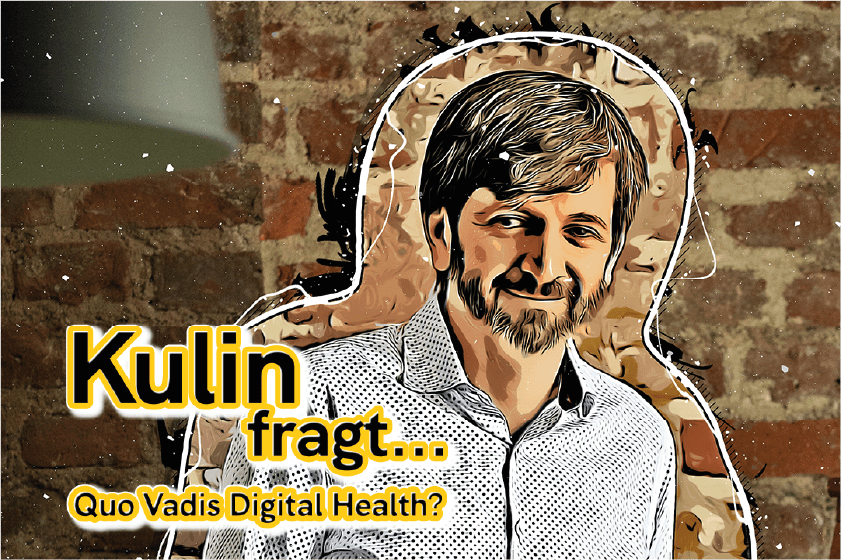New year, new luck, you might think, if you take the spirit of optimism that prevailed in the healthcare sector in the first few weeks as a yardstick. So what is the potential of this year and which topics are currently dominating?
After the first four weeks of the new year, I had to ask myself where the industry actually stood. And this time, I really couldn’t decide on a single topic that I’ll be analyzing in greater depth as part of Quo Vadis Digital Health in January. It is the overall situation that deserves a closer look and can sometimes already reveal where the journey may be headed in the new year.
For example, there is the hospital reform, the new major project of our Federal Minister of Health, which is currently prominently represented in the headlines. What’s remarkable about the status quo here: We are in a phase in which numerous recommendations are already being discussed more or less publicly – even before the draft bill and without really involving the actual care providers. Those who provide care on a daily basis are therefore not yet being heard. What’s more, some German states are even anticipating the reform. For example, the new Minister of Health in Lower Saxony, Andreas Philippi, has announced that a hospital ordinance necessary for the restructuring of the hospital landscape in the state could probably come into force in the first quarter. This would allow Lower Saxony to start reforming its hospital structures even before the planned federal law on hospital reform is in place, Philippi emphasized during the corresponding debate in the state parliament. His counterpart from Mecklenburg-Western Pomerania, Stefanie Drese, is supporting him with her arguments, and also emphasizes that hospital planning must remain a matter for the state. And North Rhine-Westphalia’s Minister of Health, Karl-Josef Laumann, had already announced at the beginning of January that the state would initially pursue its own path and draw up proposals for the future concentration of its hospitals by May. The North Rhine-Westphalian state parliament had passed a new hospital reform law in 2021.
Unity and actionism
On the positive side, everyone seems to agree that now is a good time to make changes. However, this must not degenerate into a power poker between the parties, and a patchwork quilt with isolated solutions at the state level is certainly not the last word in wisdom – especially since the hospitals have not even begun to work through their other mammoth task, the KHZG, and also have to face major financial challenges due to inflation. 60 percent of German hospitals would be in the red by 2022, reports Dr. Markus Horneber, CEO of Agaplesion gAG, in an interview with ARD. And that’s why large hospital groups are now only serving their patients margarine instead of butter – not for medical reasons, but because this saves hundreds of thousands of euros in purchasing, as Spiegel magazine has investigated in the case of the Asklepios healthcare group.
In concrete terms, this means that reforms are urgently needed. In my view, the exchange with the service providers just needs to be conducted much more closely than has been the case to date. It is important that within this discourse, lobbyists are not equated with the people who take real responsibility within care, focus on patients and have valuable insights into what can and perhaps must be done better.
If this dialogue does not succeed, it is entirely possible that the quality of care will suffer as a result of hospital reform – especially if it really is viewed in as isolated a way as its name currently suggests. After all, reform also means discussing the profitability and continued existence of today’s hospitals. And then it becomes clear that such a discussion means the end for some locations, which in turn leads to the creation of new medical care centers and thus gives the holistically conceived regional care a completely new significance. It would be too short-sighted not to think about necessary reforms across sectors (implementation can take place successively).
Innovations from outside the sector
Long-term, cross-sector projects are also necessary, however, because elsewhere the blinker is already being set to overtake. Many digital innovations such as blockchain have not even peripherally touched the healthcare sector. However, this is likely to be quite different with the rapid development of artificial intelligence. Which brings us to the next “hot topic” that dominated the headlines in January: ChatGPT. The prototype of a chatbot based on machine learning can answer questions in a well-founded manner, write essays and applications – or even possibly make a diagnosis from symptoms, true to the motto “Ask ChatGPT instead of Dr. Google”. At least at the headquarters there, those responsible are worried that OpenAI’s bot could become a real competitor for the search engine.
Innovations like ChatGPT can be perceived as a threat, but also as an opportunity. After all, artificial intelligence is only as good as the knowledge provided to it by human experts. And that can be a relief, for example because the AI has been fed all the drug interactions that no physician can know by heart. Does this mean that doctors will become superfluous? Certainly not, because the information always has to be checked. But it saves an immense amount of time if you can ask the chatbot instead of poring over lists or looking things up yourself using a search engine.
Light and shadow
Which brings us to another essential topic: Cybercrime. The number of attacks in the healthcare sector is also on the rise. Logically, with a higher degree of digitalization. This is not unusual, nor are we alone as an industry facing this challenge. We just need to be aware that it is one. In mid-January, it became known that IT service provider Bitmarck had been hacked. The company operates electronic patient records for 87 statutory health insurers. According to the company, health data was not affected, but the attackers were probably able to gain access to company data.
The German Federal Office for Information Security (BSI) also seems to be aware of the growing interest of cybercriminals and is investigating the IT security of medical practice software as part of a newly launched project. The aim is to examine exemplary products in terms of IT security in collaboration with the manufacturers. The key word here: collaborative! With increasing digitization in the healthcare sector, it is also important to continuously raise security standards. And this can only be achieved in close cooperation with all stakeholders. The goal must be to pool resources. This is the only way to operate and maintain secure clouds. The dangers are real and too great to be solved in a lone wolf manner.
However, what the mixed situation – no matter how complex – clearly shows is that an incredible amount is happening in very different areas. This means that the critical mass of people who want to move, change and achieve something in healthcare has been reached. Things are clearly moving forward, and I am convinced that with this motivation, we can succeed in giving the healthcare sector a new, digital, patient-centric face that values professionals. The chances are good that the Smart Health Evolution will reach a new stage of development in 2023. I, for one, am already very excited. Because my hope is that a truly overarching digital strategy emerges from the current mishmash, one that has the potential to re-orchestrate the care we have been providing, to sort it all out properly. I would like to be able to analyze the first results of such a strategy very soon – perhaps in this very space.

